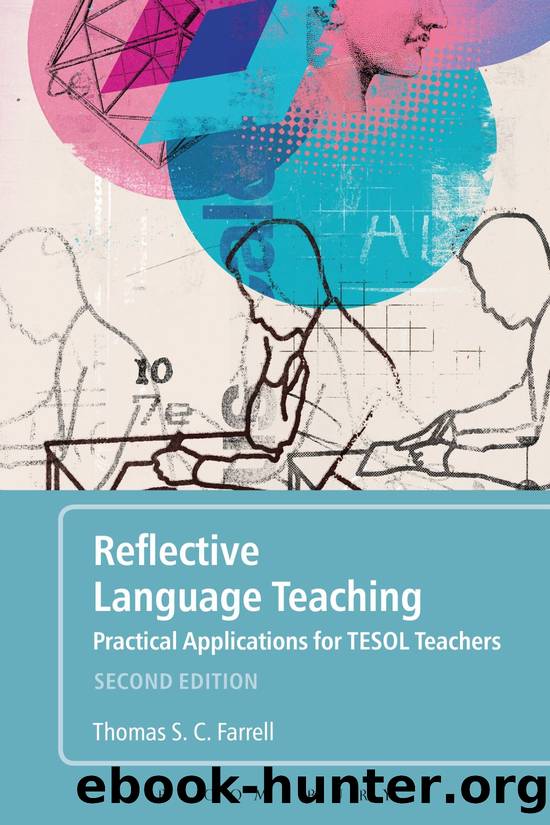Reflective Language Teaching by Thomas S. C. Farrell

Author:Thomas S. C. Farrell
Language: eng
Format: epub
Publisher: Bloomsbury Publishing Plc
10
Teacher Development Groups
Chapter Outline
Introduction
Teacher development groups
Case study I: Experienced language teachers in group reflections
Case study I reflection
Case study II: “I’ve Plateaued . . . Gone A Little Stale.”
Case study II reflection
Case study III: Novice language teachers in group reflections
Case study III reflection
Practical applications for TESOL teachers
Reflection
Conclusion
Chapter scenario
Reflection
Introduction
Since the day they started to teach, teachers have been socialized to work in isolation from their colleagues and this has led to feelings of insecurity because teachers may be afraid to share their experiences with other teachers for fear of being “exposed.” However, if teachers come together on their own initiative in order to reflect on their work, they can complement individual members’ strengths, and compensate for each member’s limitations, all for the common good of the group and the institutions in which they work. As Little (1993: 138) has pointed out one principle of professional development for language teachers is that it can offer “meaningful intellectual, social, and emotional engagement with ideas, with materials, and with colleagues both in and out of teaching.” This chapter outlines and discusses how teachers can work together when they volunteer to join a teacher development group in order to form relationships with colleagues in order to discuss, share, and reflect on their beliefs and practices both inside and outside the classroom.
Teacher development groups
Teacher development groups provide a context where participants can reflect on and come to understand their classroom practices, and plan their professional growth and development together in a safe place. Head and Taylor (1997: 91) define a teacher development group as “any form of co-operative and ongoing arrangement between two or more teachers to work together on their own personal and professional development.” Teachers as well as other members of a school (or teachers from different schools) come together in such groups or networks in order to improve their teaching and their students’ learning through collaboration on the basic assumption that collaborating with a group of colleagues will be more effective than reflecting alone. Research suggests that collaboration is an important component of teacher professional development because it involves teachers sharing their personal and professional knowledge with other teachers. As a result of participating in teacher development groups, teachers can change their thinking about their work and as a result can become more confident practitioners (Matlin and Short, 1991).
Research indicates that language teacher development groups facilitate dialogue, sharing and collaboration, and the exchange of resources, information, and expertise.
For example, after realizing that they have been pursuing their own professional development in isolation for several years as individual language teachers, three language teachers in the United States decided to come together in a teacher development group not only for the purposes of reflecting on their practice but also as a means of offering “hope to others wishing to break out of the shells of isolation separating teachers from their colleagues as well as from teacher educators” (Oprandy, Golden and Shiomi, 1999: 152). Oliphant (2003) has observed that language teachers join a teacher development group in
Download
This site does not store any files on its server. We only index and link to content provided by other sites. Please contact the content providers to delete copyright contents if any and email us, we'll remove relevant links or contents immediately.
| Arts & Humanities | Health |
| Language Arts | Library Skills |
| Mathematics | Reading & Phonics |
| Science & Technology | Social Studies |
The Art of Coaching Workbook by Elena Aguilar(50033)
Trainspotting by Irvine Welsh(20940)
Twilight of the Idols With the Antichrist and Ecce Homo by Friedrich Nietzsche(18266)
Fangirl by Rainbow Rowell(8751)
Periodization Training for Sports by Tudor Bompa(7887)
Change Your Questions, Change Your Life by Marilee Adams(7317)
This Is How You Lose Her by Junot Diaz(6400)
Asking the Right Questions: A Guide to Critical Thinking by M. Neil Browne & Stuart M. Keeley(5317)
Grit by Angela Duckworth(5260)
Red Sparrow by Jason Matthews(5165)
Paper Towns by Green John(4751)
Room 212 by Kate Stewart(4700)
Ken Follett - World without end by Ken Follett(4409)
The Sports Rules Book by Human Kinetics(4041)
Housekeeping by Marilynne Robinson(4014)
Double Down (Diary of a Wimpy Kid Book 11) by Jeff Kinney(3871)
Papillon (English) by Henri Charrière(3869)
The Motorcycle Diaries by Ernesto Che Guevara(3753)
Exercise Technique Manual for Resistance Training by National Strength & Conditioning Association(3747)
